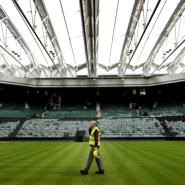He is next in line and has been since Novak Djokovic split the Roger Federer-Rafael Nadal hegemony at the Australian Open in 2008, after which the pair closed ranks again, extending their dominion to 15 of the past 16 grand-slam tournaments.
Andy Murray is now in the position of man most likely, heir apparent, expectant champion.
“I had played the final of the US Open and a couple of semi-finals at the French Open and Wimbledon and that obviously proved my quality,” Djokovic, the Serb, said yesterday, reminiscing about his Melbourne breakthrough. “I wasn't sure, firstly for myself and then for everybody else, that I was able to do that, to make that final step. It is a whole different world when you win one [a grand slam], with more appreciation from your colleagues, the people, tennis lovers everywhere.”
Nadal, who broke his grand-slam duck at the French Open in 2005, is seeking to win his fifth consecutive title and could also recall his days of doubt. “All your life you are working for that moment,” he said. “It was difficult to accept when everyone was saying I was the favourite [in 2005] but I won. It was really, really special.”
Murray is in the same half of the Roland Garros draw as Nadal and said that he would be shocked if the Spaniard did not reach the final, so perhaps we should not expect to see Scottish hands clasping the Coupe des Mousquetaires tomorrow fortnight. At Wimbledon? That's a discussion for another day.
In the first round, Murray plays Juan Ignacio Chela, one of the players Tim Henman defeated en route to the Paris semi-finals five years ago. Tall and angular, the Argentinian ought to be right at home in these surroundings, but he has reached the second week only once in eight attempts.
Murray is unlikely to be rushing the net as Henman did until he went a set up in the semi-final against Guillermo Coria, became aware of the immensity of what he was about to achieve and froze. The present British No 1 is more tortoise than hare, biding his time, injecting the venom and waiting for it to spread.
“What I've done better this year is not to treat clay as a different surface, to totally change my game pattern,” Murray said. “Against the clay-courters, you can try to make it a hard-court match by playing a little bit flatter, coming to the net more and shortening the points.
“I do feel much more comfortable. Physically, I feel better. I did not have the best run coming into the French Open last year so confidence is a big factor this time. But there are things I could do better, like returning.”
Nadal might have been expecting a few searching questions after his loss to Federer in the final of the Mutua Madrileña Masters in Madrid last Sunday, and was not disappointed. A clay-court defeat for the Spaniard equates to a 7.5 reading on the Richter Scale. Nadal said that he accepted it as a hazard of the job.
It was mentioned that conditions here are appreciably slower and heavier than in the Spanish capital. His eyes twinkled. “In Madrid, you touch the ball, the ball goes out of the racket very fast and very early,” he said. “Here, the feeling is that the ball stays here, you can feel it more. It may be heavier, but for me, it is easier to play.”
Nadal was asked to confirm that he had said that the French Open is the most beautiful tournament in the world. Nadal, mindful of his diplomatic status, interrupted. “No, I never said that, because I like a lot of tournaments,” he said. “But sure, it is one of the nicest.” And one that nobody in their right mind can see anyone else winning.
Source:The times
Saturday, May 23, 2009
Subscribe to:
Post Comments (Atom)











No comments:
Post a Comment